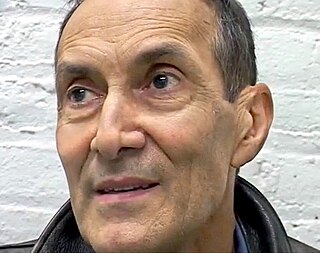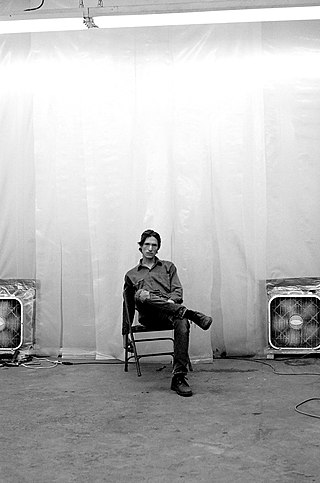
Malcolm A. Morley was a British-American visual artist and painter. He was known as an artist who pioneered in various styles, working as a photorealist and an expressionist, among many other genres.

Robert Ryman was an American painter identified with the movements of monochrome painting, minimalism, and conceptual art. He was best known for abstract, white-on-white paintings. He lived and worked in New York City.

The Hamburger Kunsthalle is the art museum of the Free and Hanseatic City of Hamburg, Germany. It is one of the largest art museums in the country. It consists of three connected buildings, dating from 1869, 1921 (Kuppelsaal) and 1997, located in the Altstadt district between the Hauptbahnhof and the two Alster lakes.

The Brooklyn Rail is a publication and platform for the arts, culture, humanities, and politics. The Rail is based in Brooklyn, New York. It features in-depth critical essays, fiction, poetry, as well as interviews with artists, critics, and curators, and reviews of art, music, dance, film, books, and theater.
Phong H. Bui is an artist, writer, independent curator, and Co-Founder and Artistic Director of The Brooklyn Rail, a free monthly arts, culture, and politics journal. Bui was named one of the "100 Most Influential People in Brooklyn Culture" by Brooklyn Magazine in 2014. In 2015, The New York Observer called him a "ringmaster" of the "Kings County art world." Bui was the recipient of the 2021 American Academy of Arts and Letters Award for Distinguished Service to the Arts. He lives in Greenpoint, Brooklyn.
Kai Althoff is a German visual artist and musician.

William Anastasi was an American visual artist working in a wide range of media including drawing, painting, sculpture, photographic works, and text. He lived and worked in New York City from the early 1960s and was known as "one of the most underrated conceptual artists of his generation".

Dorothea Rockburne DFA is an abstract painter, drawing inspiration primarily from her deep interest in mathematics and astronomy. Her work is geometric and abstract, seemingly simple but very precise to reflect the mathematical concepts she strives to concretize. "I wanted very much to see the equations I was studying, so I started making them in my studio," she has said. "I was visually solving equations." Her attraction to Mannerism has also influenced her work.
Ron Gorchov was an American artist. He was known for his colorful, abstract paintings on curved canvases.
Cordy Ryman, an artist based in New York City. Ryman earned his BFA with Honors in Fine Arts and Art Education from The School of Visual Arts in New York in 1997. He is the son of artist Robert Ryman (1930-2019). Cordy Ryman is represented by Freight and Volume Gallery, New York, NY.
Irving Sandler was an American art critic, art historian, and educator. He provided numerous first hand accounts of American art, beginning with abstract expressionism in the 1950s. He also managed the Tanager Gallery downtown and co-ordinated the New York Artists Club of the New York School from 1955 to its demise in 1962 as well as documenting numerous conversations at the Cedar Street Tavern and other art venues. Al Held named him, "Our Boswell of the New York scene," and Frank O'Hara immortalized him as the "balayeur des artistes" because of Sandler's constant presence and habit of taking notes at art world events. Sandler saw himself as an impartial observer of this period, as opposed to polemical advocates such as Clement Greenberg and Harold Rosenberg.
David Reed is a contemporary American conceptual and visual artist.
Ellen Phelan is an American artist known especially as a painter of formalist abstractions, psychologically charged scenes enacted by dolls, and landscapes.
Nahid Hagigat or Nahid Haghighat is an Iranian-American illustrator and artist, located in New York City. She is well known for her paintings and prints with layered imagery.

Max Hollein is an Austrian art historian and the current CEO and Director of the Metropolitan Museum of Art in New York City. He served as Director and CEO of the Fine Arts Museums of San Francisco from July 2016, until April 2018, the Metropolitan Museum of Art announced that Hollein would become its 10th director.

Gary Stephan is an American abstract painter born in Brooklyn who has exhibited his work throughout the United States and Europe.

Daniel Turner is an American artist based in New York City. His media include sculpture, photography, video and drawing.
David Humphrey is an American painter, art critic, and sculptor associated with the postmodern turn in painting that began in the late 1970s. He is best known for his playful, cartoonish, puzzling paintings, which blend figuration and abstraction and create "allegories" about the medium of painting itself. Humphrey holds a BFA from Maryland Institute College of Art (1977) and a MA from New York University (1980), where he studied with film critic Annette Michelson; he also attended the New York Studio School from 1996 – 1997. He has been the recipient of many awards including the Guggenheim Fellowship in 2002, the Rome Prize in 2008, and the American Academy of Arts and Letters Purchase Award in 2011. He was born in Augsburg Germany and raised in Pittsburgh, Pennsylvania. He lives and works in New York City.
John Newman is an American sculptor. He was born in Flushing, Queens in 1952. He received his B.A. from Oberlin College (1973). He attended the Whitney Museum Independent Study Program in 1972 and received his M.F.A. in 1975 from the Yale School of Art. He was a fellow at the Center for Advanced Visual Studies at MIT from 1975 to 1978. He is based in New York City.
David Ross Novros, is an American artist. He is known for his minimalist geometric paintings, shaped canvases, and his use of color. He has also studied fresco painting extensively.











